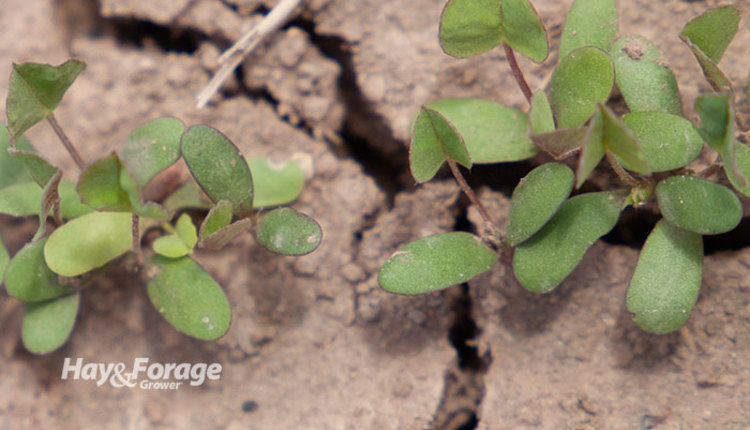
With the turning of the calendar to August next week, the window opens for Northern regions to begin seeding alfalfa and alfalfa-grass mixtures. That window progresses to later dates as we move south.
A lack of soil moisture has always been a concern with late-summer alfalfa seedings. A dry spell immediately following a new seeding, or even worse, a modest shower that’s just enough to germinate the seed but no more, can often spell disaster for late-summer alfalfa seedings.
In 2023, the risk of dry weather after seeding is enhanced by the fact that many fields are already parched by some level of drought. This includes many regions where summer rainfall is at least adequate. Of course, this doesn’t hold for everyone, as many states in the Northeast have been deluged with rain, for example.
Seeding alfalfa late in the growing season is standard practice in many regions of the U.S., especially the South where hot, dry spring conditions can be a concern. In the North, delayed germination from inadequate moisture raises the risk of stand failure because crowns and roots don’t develop enough to withstand a harsh winter. Typically, it’s recommended that alfalfa seedlings have at least four trifoliolate leaves once the growing season ends.
In dry areas that remain dry in 2023, the decision of when to seed becomes more complicated. On the one hand, there is nothing gained seeding into dry soil with no significant rainfall in the immediate forecast. On the other hand, waiting too long may not allow for enough plant growth before winter. Once again, it all comes down to moisture.
There is one caveat to all of this thinking. On average, growing seasons are longer than they were 25 or more years ago. This translates into later seeding dates that will still allow for adequate plant growth, assuming the growing season isn’t halted by unseasonably early cold temperatures.
Not time to give up
Even with the unusual, if not extreme, weather events of this summer, late-summer seedings remain a viable option at this point in the growing season.
One of the advantages of late summer seedings is that those pesky alfalfa seedling root diseases are often less of a problem under drier, warmer conditions. Other advantages include:
1. Weeds and insects seldom limit stand establishment.
2. A companion crop is never recommended, and an herbicide application is often not needed. Exceptions include: Glyphosate in the case of Roundup Ready varieties or following a cereal grain where volunteer grass plants are sometimes problematic.
3. The near equivalent of an established stand yield is realized in the year following a late-summer seeding.
Seeding dates will depend on location, but a general rule of thumb is six to nine weeks before the first killing freeze. Five weeks is usually where I'd recommend keeping your seed in the bag. Seeding too early enhances the risk for hot, dry conditions during seedling establishment; seeding too late does not give plants enough time to develop adequate root and top growth for winter survival. With adequate moisture, it's better to error too early than too late.
As a general rule, recommended seeding practices for spring seedings apply to late-summer seedings from a soil fertility, seeding rate, and seedbed preparation standpoint. It is worth mentioning that a firm seedbed to optimize seed-to-soil contact is especially important with late-summer seedings. No-till seedings in late summer have also been successful and may help to conserve available soil moisture.
Barring a rapid change in weather patterns, late-summer seedings might be more challenging this year, but they still offer opportunity for success with proper timing.

